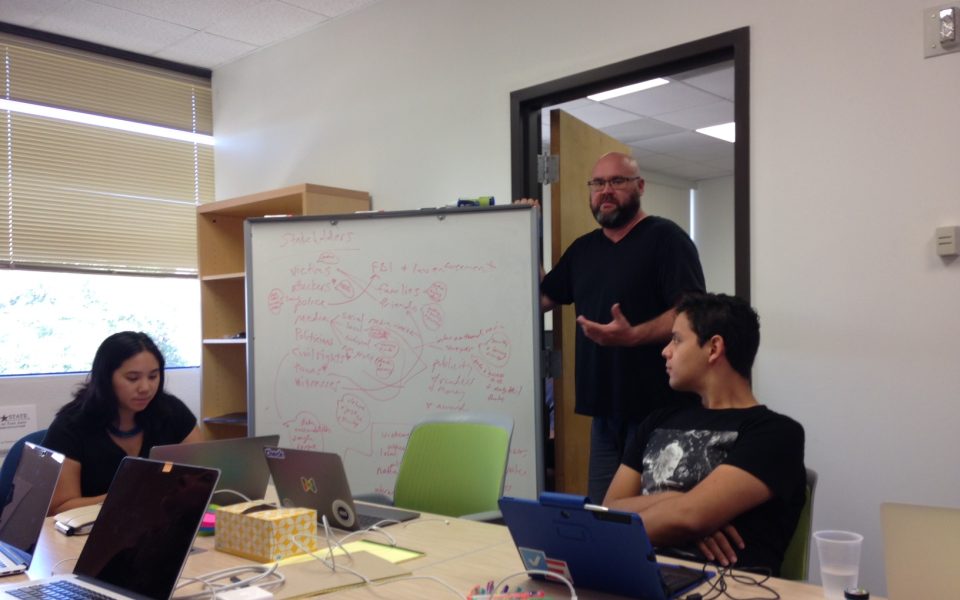The light had begun to soften as dusk cloaked the newborn suburbia along Interstate 35 in the booming town of Kyle south of Austin, but the heat was still on a low broil on a recent Friday evening as I found myself seated in a Tex-Mex restaurant between two Brits trading war stories about the 2011 uprising in Cairo’s Tahrir Square.
The next morning, a dozen of us — journalists, programmers, students and an instructor, variously from Miami, Los Angeles, San Francisco, New York City and North Carolina — would hole up in a narrow conference room on the campus of Texas State University in San Marcos to design a system to harvest and verify information from social media about hate crimes.
Fergus Bell, one of the journalists with experience covering the Arab Spring, was joking at dinner that the Americans had to call on a couple Brits because he and Tom Trewinnard were among the few people with social-media verification expertise.
It seems telling that their professional transitions from journalists to technology developers have led them from there to here. Social-media verification came into its own as an important journalistic tool during the course of the Syrian civil war, in which the strict control of the Assad regime coupled with the ferocity of the conflict has limited the ability of journalists to operate on the ground. The tool has also been used for projects designed to support reporting on the 2016 US election and the recent presidential election in France. As Facebook, Twitter and other social-media platforms have attracted increasing numbers of users, they have become both a conduit of valuable information and a channel for hoaxes and disinformation.
In the shell-shocked aftermath of Charlottesville, sitting with two journalists molded by experience covering the Egyptian revolution, it felt in some sense like the war had come home.
I’ll be working with a group of students at Wake Forest University under the direction of professor Phoebe Zerwick this fall to scrape the internet for bias incidents and then cross-reference social-media posts to ascertain the who, what, when and where. In tandem with peers across the country, the Wake students will be feeding the information into a giant database curated by ProPublica’s Documenting Hate project to both generate news stories and develop a more comprehensive picture of hate in the United States.
Charlottesville was conspicuously represented in the stack of entries already compiled. One incident highlighted by the trainers for demonstration purposes referenced the brutal beating of Deandre Harris by white supremacists at the Water Street Parking Garage in Charlottesville on Aug. 12.
The timing of the training was eerie, coming exactly a week after Charlottesville, and only days after President Trump gave a tacit endorsement of the white supremacist movement by saying there were “very fine people” at the Unite the Right rally and that the Confederate monuments are “beautiful.” The last 10 days have felt like a turning point into more dangerous and volatile territory.
As P. Kim Bui, one of the trainers, projected a Google Earth image of a private driveway in northern California displaying a “Don’t Tread on Me” flag, I couldn’t help noting that the same tool was used by journalists to verify a chemical weapons attack in Syria.
Although rhetoric urging victims to “go back to your country” has been a common feature of bias incidents in the United States this year, people are being targeted for every conceivable reason — race, religion, immigration status and sexual orientation, to name a few — in every part of the country, according to Rachel Glickhouse, the partner manager for Documenting Hate.
It felt like a secretive kind of Manhattan Project racing against hate, as we broke into groups to design workflow features and brainstorm search terms, including a working lunch of pizza.
It wasn’t all work. At 4:30 p.m. on the first day, we broke for a tubing excursion down the San Marcos River. The river was clogged with flotillas tethered together by ropes and affectionate handclasps, as exuberant voices signaled across the stream and the faint smell of marijuana perfumed the air.
At one point I looked over my shoulder and heard a woman call out, “Hey, you Mexican f***,” but it wasn’t immediately clear whom the intended target was, and no one responded.
At the end of the run, two groups exchanged heated words and one man took a fighting stance before a friend restrained him.
Then everyone piled into an ancient school bus and we bumped over the streets back to launch site. The trip passed without incident, and the tubers filed into primitive public bathrooms to change and then retrieved clothing, wallets, purses and keys to go their separate ways.
Join the First Amendment Society, a membership that goes directly to funding TCB‘s newsroom.
We believe that reporting can save the world.
The TCB First Amendment Society recognizes the vital role of a free, unfettered press with a bundling of local experiences designed to build community, and unique engagements with our newsroom that will help you understand, and shape, local journalism’s critical role in uplifting the people in our cities.
All revenue goes directly into the newsroom as reporters’ salaries and freelance commissions.


Leave a Reply